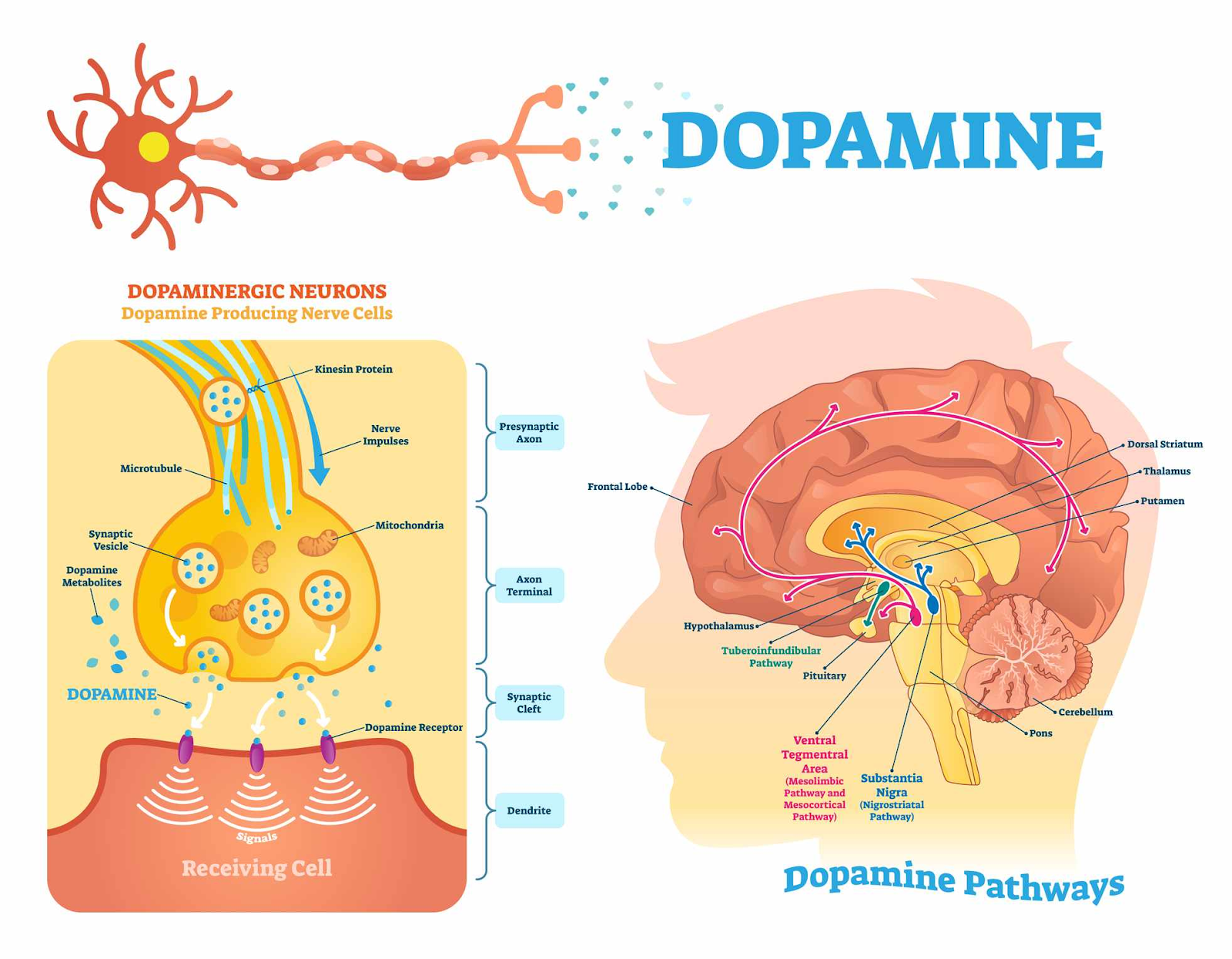Dopamine: The molecule that drives addiction
Arul Loomba . 04/23/2021

The brain craves pleasure. Going on a vacation, jumping out of a plane or even taking a bite of ice cream stimulates the action of billions of neurons - the cells in our brains that send signals throughout our body to do everything from helping us walk to reading a book. There is one chemical that does consistent and important signaling using the brain’s neurons, especially when it comes to sending information about pleasure: the neurotransmitter dopamine.
Neurotransmitters are small molecules that neurons use to communicate with one another, and they help elicit certain responses like happiness from opening a gift. They also play a substantial role in our everyday actions, including moving, running and most importantly, thinking. Dopamine, a significant neurotransmitter in the brain, influences emotional activity and response. For example, it stimulates the brain so people can concentrate on certain enjoyable actions and ignore those that don’t provide the same feeling. The molecule acts on the brain’s reward system, a neuronal pathway in the brain used for transmitting emotions; when doing an activity that brings pleasure, the reward system creates feelings of joy and craving. After the consistent release of these emotions, a person’s attention span will change: “You can’t pay attention to everything, but you want to be adept as an organism at recognizing things that are novel,” Director of the National Institute of Drug Abuse Nora D. Volkow said. Dopamine is a chemical that allows a person to concentrate on novel and attractive things - ones that we hope to receive pleasure from.
Overall, dopamine plays a significant role in motivating a person to participate in pleasurable activities. This can range from exercising to watching a movie - anything that prolongs the release of dopamine. While many times this prolongation can be healthy (as a source of motivation and effort), too much of anything can have a dark side: uncontrolled amounts of dopamine are the primary cause of drug addiction.
A recent study by Dr. Volkow illustrates that drug abuse is associated with the increased “intensity and duration” of dopamine release. Street drugs like opiates and cocaine are major drivers of addiction because they increase the concentration of dopamine that cells put out. These drugs inhibit the natural mechanisms the body has to maintain balance, which in this case regulates dopamine concentration, providing the users with a burst of satisfaction or “high.” The mechanisms that keep the levels of dopamine under control involve proteins that take excess dopamine out of circulation. By imitating the shape of the molecular repressors that inhibit reuptake proteins, drugs can have a significant effect. Long-term consequences of inhibition, include the brain growing accustomed to greater concentrations of dopamine. Moreover, in many cases, this environmental change can result in the brain stopping the natural release of dopamine, creating a reliance on drugs to maintain its concentration.
The discovery that drug addiction stems from the increased presence of dopamine in the brain also has significant treatment implications. Frequent drug users often rely on the euphoric feeling that dopamine provides to fuel their addiction - it gives them “motivation” to abuse certain substances. Volkow’s research opens up new treatment options for these addicts. For example, creating new medications that limit the dopamine “reward” that addicts feel from abused drugs can effectively eliminate the cause of addiction. Once available frequently, these treatments could be combined with rehab and therapy to encourage addicts to seek rewards from alternative sources like exercise or positive social interactions. Dopamine is naturally released at times of excitement, so gaining this in other ways would stimulate the normal neuronal pathways, and not ones related to drugs. These simple, yet important solutions, are key to fixing a problem present in many developing communities around the world. The safest, most effective way to address the issue would be changing its source: availability and composition drugs.
Volkow is optimistic about the implications of her research: “Our findings suggest that interventions designed to enhance [dopamine] brain function in drug abusers,” noting that none of this will be successful unless treatment can “provide them with non-drug alternatives” with the ultimate goal to “help the addicted subject overcome the strong drive to take the drug.” With new treatments, the brain’s craving can be overcome.
Cover Photo: (Getty Images / Stock Photo)

Arul is currently a sophomore at Rancho Cucamonga High School in California. He has a deep passion for biomedicine and is looking to pursue regenerative medicine in the future. Currently, he is trying to research articles and data collected by many professors to formulate his theories and ideas! Arul is also a fan of cooking, playing tennis, and writing.